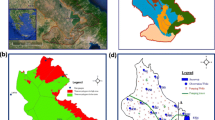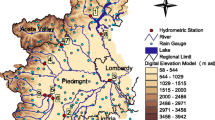Abstract
Climate variability due to the greenhouse effect has important implications on hydrological processes and water resources systems. Indeed, water availability, quality and streamflow are very sensitive to changes in temperature and precipitation regimes whose effects have to be fully considered in current water management and planning. International literature proposes several models, attempting to assess accurately the available water resources under stationary and changing climatic conditions at different spatial and temporal scales. In order to assess the potential impacts of climate change on surface and groundwater resources water availability in a Southern area of Italy, a conceptual hydrologic model, the TOPDM, was applied at daily scale to simulate the hydrological processes in the Belice river basin, located in Sicily and which feeds an artificial lake. The analysis of climatic forcings trend provided the parameters needed in order to generate synthetic climate forcing series through the use of the AWE-GEN, an hourly weather generator, able to reproduce the characteristics of hydro-climatic variables and their statistical properties. . The hydrological model was used to estimate the basin water balance components and the surface and groundwater availability, at annual and monthly scale, in a no trend scenario, representing the current climate conditions, and in three different groups of scenarios, in which a decrease of precipitation, an increase of temperature, and a combination of these effect were reproduced. The application of TOPDM to the test basin provided some important conclusions about the implications of climate change in the Southern part of Italy. Results showed that runoff and evapotranspiration reflect variations in precipitation and in temperature; in particular the negative trend in precipitation determines a decrease in surface and groundwater resources, and this effect is intensified in the scenarios that include an increase in potential evapotraspiration as well. The consequences of changes on water supply system were also analyzed through a simple balance evaluation of the lake water reservoir, in order to assess the possible impacts on the resource managements. Results indicated an exacerbation of the water resources stresses, in which water scarcity is already an important issue for water resource management. The analysis provides useful information about the quantification of the potential effects of climate change in the area of study, in order to develop new strategies to deal with these changes.







Similar content being viewed by others
References
Alcamo J, Döll P, Henrichs T, Kaspar F, Lehner B, Rösch T, Siebert S (2003) Development and testing of the WaterGAP 2 global model of water use and availability. Hydrol Sci J 48:317–337. doi:10.1623/hysj.48.3.317.45290
Allen RG, Pereira LS, Raes D, Smith M (1998) Crops evapotranspiration: Guidelines for computing crop water requirements. Irrigations and Drainage. Paper 56, FAO, Rome, 300 pp
Alpert P, Ben-Gai T, Baharad A, Benjamini Y, Yekutieli D, Colacino M, Diodato L, Ramis C, Homar V, Romero R, Michaelides S, Manes A (2002) The paradoxical increase of Mediterranean extreme daily rainfall in spite of decrease in total values. Geophys Res Lett 29:1–31. doi:10.1029/2001GL013554
Arnell NW, van Vuuren DP, Isaac M (2011) The implications of climate policy for the impacts of climate change on global water resources. Glob Environ Chang 21:592–603. doi:10.1016/j.gloenvcha.2011.01.015
Arnone E, Pumo D, Viola F, Noto LV, La Loggia G (2013) Rainfall statistics changes in Sicily. Hydrol Earth Syst Sci 17:2449–2458. doi:10.5194/hess-17-2449-2013
Aronica G, Cannarozzo M, Noto L (2002) Investigating the changes in extreme rainfall series recorded in an urbanised area. Water Sci Technol 45:49–54
Beguería S, Vicente-Serrano SM, López-Moreno JI, García-Ruiz JM (2009) Annual and seasonal mapping of peak intensity, magnitude and duration of extreme precipitation events across a climatic gradient, northeast Spain. Int J Climatol 29:1759–1779
Bekele EG, Knapp HV (2010) Watershed modeling to assessing impacts of potential climate change on water supply availability. Water Resour Manag 24(13):3299–3320
Beven KJ, Kirkby MJ (1979) A physically-based variable contribution area of model. Hydrol Hydrol Sci Bull 24:43–69
Boithias L, Acuña V, Vergoñós L, Ziv G, Marcé R, Sabater S (2014) Assessment of the water supply: DEmand ratios in a Mediterranean basin under different global change scenarios and mitigation alternatives. Sci Total Environ 470–471:567–577
Brunetti M, Buffoni L, Maugeri M, Nanni T (2000) Precipitation intensity trends in northern Italy. Int J Climatol 20:1017–1031
Cannarozzo M, Noto LV, Viola F (2006) Spatial distribution of rainfall trends in Sicily (1921–2000). Phys Chem Earth 31:1201–1211
Charlton MB, Arnell NW (2011) Adapting to climate change impacts on water resources in England—an assessment of draft water resources management plans. Glob Environ Chang 21:238–248. doi:10.1016/j.gloenvcha.2010.07.012
Chow VT, Maidment DR, Mays LW (1988) Applied hydrology. McGraw-Hill, New York
Christensen N, Wood A, Voisin N, Lettenmaier D, Palmer R (2004) Effects of climate change on the hydrology and water resources of the Colorado River basin. Clim Chang 62:337–363
Fatichi S, Ivanov VY, Caporali E (2011) Simulation of future climate scenarios with a weather generator. Adv Water Resour 34(4):448–467
Fatichi S, Ivanov VY, Caporali E (2013) Assessment of a stochastic downscaling methodology in generating an ensemble of hourly future climate time series. Clim Dyn 40(7–8):1841–1861
Ficklin DL, Luo Y, Luedeling E, Zhang M (2009) Climate change sensitivity assessment of a highly agricultural watershed using SWAT. J Hydrol 374(1):16–29
Fiering MB (1967). Streamflow synthesis. Macmillan London
García-Ruiz JM, López-Moreno JI, Vicente-Serrano SM, Lasanta–Martínez T, Beguería S (2011) Mediterranean water resources in a global change scenario. Earth Sci Rev 105:121–139. doi:10.1016/j.earscirev.2011.01.006
Gleick PH (1987) The development and testing of a water balance model for climate impact assessment: modeling the Sacramento basin. Water Resour Res 23(6):1049–1061
Gottschalk L, Motovilov Y (2000) Macro-scale hydrological modeling: a Scandinavian experience. International Symposium on: ‘Can Science and Society Save the Water Crisis in the 21st Century: Reports from the World’, 1, 2000, Tokyo: Anais. Japan Society of Hydrology and Water Resources, Tokyo, pp. 38–45
Klein Tank AMG, Können GP (2003) Trends in Indices of daily temperature and precipitation extremes in Europe, 1946–99. J Clim 16:3665–3680
Iglesias A, Garrote L, Flores F, Moneo M (2007) Challenges to manage the risk of water scarcity and climate change in the Mediterranean. Water Resour Manag 21(5):775–788
IPCC. Special report on emissions scenarios (2000) A special report of working group III of the intergovernmental panel on climate change. Cambridge University Press, Cambridge and New York
IPCC. Climate change (2013) The physical science basis. Contribution of working group I to the fifth assessment report of the intergovernmental panel on climate change. Cambridge University Press, Cambridge and New York
Ivanov VY, Bras RL, Curtis DC (2007) A weather generator for hydrological, ecological, and agricultural applications. Water Resour Res 43:W10406. doi:10.1029/2006WR005364
Lahmer W, Pfützner B, Becker A (2001) Assessment of land use and climate change impacts on the mesoscale. Phys Chem Earth Part B: Hydrol Ocean Atmos 26(7):565–575
Lettenmaier DP, Gan TY (1990) Hydrologic sensitivities of the Sacramento-San Joaquin River Basin, California, to global warming. Water Resour Res 26(1):69–86
Lionello P, Malanotte-Rizzoli P, Boscolo R, Alpert P, Artale V, Li L, Luterbacher J, May W, Trigo R, Tsimplis M, Ulbrich U, Xoplaki E (2006) The Mediterranean climate: an overview of the main characteristics and issues. Dev Earth Environ Sci 4:1–26
Liuzzo L, Noto LV, Vivoni ER, La Loggia G (2010) Basin-scale water resources assessment in oklahoma under synthetic climate change scenarios using a fully distributed hydrologic model. J Hydrol Eng 15:107–122
Lloyd-Hughes B, Saunders MA (2002) A drought climatology for Europe. Int J Climatol 22:1571–1592
Meehl GA, Stocker TF, Collins WD, Friedlingstein P, Gaye AT, Gregory JM, Kitoh A, Knutti R, Murphy JM, Noda A, Raper SCB, Watterson IG, Weaver AG, Zhao ZC (2007) In: Solomon S, Qin D, Manning M, Chen Z, Marquis M, Averyt KB, Tignor M, Miller HL (eds) Global climate projections, in: climate change 2007: the physical science basis, contribution of working group I to the fourth assessment report of the intergovernmental panel on climate change. Cambridge University Press, Cambridge and New York
Moore RJ (1985) The probability-distributed principle and runoff production at point and basin scales. Hydrol Sci J 30(2):273–297
Moore RJ (2007) The PDM rainfall-runoff model. Hydrol Earth Syst Sci 11(1):483–499
Moore RJ, Bell VA (2003) Incorporation of groundwater losses and well level data in rainfall-runoff models illustrated using the PDM. Hydrol Earth Syst Sci 6(1):25–38
Narsimlu B, Gosain AK, Chahar BR (2013) Assessment of future climate change impacts on water resources of upper sind river basin, India using SWAT model. Water Resour Manag 27(10):3647–3662
Nash JE, Sutcliffe JV (1970) River flow forecasting through conceptual models part I—a discussion of principles. J Hydrol 10(3):282–290
Němec J, Schaake J (1982) Sensitivity of water resource systems to climate variation. Hydrol Sci J 27(3):327–343
Nicault A, Alleaume S, Brewer S, Carrer M, Nola P, Guiot J (2008) Mediterranean drought fluctuation during the last 500 years based on tree-ring data. Clim Dyn 31:227–245
Noto LV, La Loggia G (2007) Derivation of distributed unit hydrograph integrating GIS and remote sensing. J Hydrol Eng 12(6):639–650
Noto L (2013) Exploiting the topographic information in a PDM - based conceptual hydrological model. J Hydrol Eng. doi:10.1061/(ASCE)HE.1943-5584.0000908
Schneider C, Laizé CLR, Acreman MC, Flörke M (2013) How will climate change modify river flow regimes in Europe? Hydrol Earth Syst Sci 17:325–339. doi:10.5194/hess-17-325-2013
Tebaldi C, Mearns L, Nychka D, Smith R (2004) Regional probabilities of precipitation change: a Bayesian analysis of multi-model simulations. Geophys Res Lett; 31(L24213)
Ulbrich U, May W, Li L, Lionello P, Pinto JG, Somot S (2006) The Mediterranean climate change under global warming. In: Lionello P, Malanotte-Rizzoli P, Boscolo R (eds) Mediterranean climate variability and predictability. Elsevier, 415, p 398
van der Schrier G, Briffa KR, Jones PD, Osborn TJ (2006) Summer moisture variability across Europe. J Clim 19:2818–2834
Van Ty T, Sunada K, Ichikawa Y, Oishi S (2012) Scenario-based impact assessment of land use/cover and climate changes on water resources and demand: a case study in the Srepok River Basin, Vietnam—Cambodia. Water Resour Manag 26(5):1387–1407
Veijalainen N, Dubrovin T, Marttunen M, Vehviläinen B (2010) Climate change impacts on water resources and lake regulation in the Vuoksi watershed in Finland. Water Resour Manag 24(13):3437–3459
Viola F, Liuzzo L, Noto LV, Lo Conti F, La Loggia G (2014) Spatial distribution of temperature trends in Sicily. Int J Climatol 34:1–17. doi:10.1002/joc.3657
Xu CY (2000) Modelling the effects of climate change on water resources in central Sweden. Water Resour Manag 14(3):177–189
Author information
Authors and Affiliations
Corresponding author
Rights and permissions
About this article
Cite this article
Liuzzo, L., Noto, L.V., Arnone, E. et al. Modifications in Water Resources Availability Under Climate Changes: A Case Study in a Sicilian Basin. Water Resour Manage 29, 1117–1135 (2015). https://doi.org/10.1007/s11269-014-0864-z
Received:
Accepted:
Published:
Issue Date:
DOI: https://doi.org/10.1007/s11269-014-0864-z




